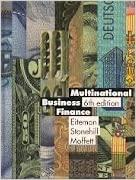Question
Company Analysis: Dan no longer works for Alphabet, but he has a relatively large amount of his personal wealth tied up in both company stock
Company Analysis:
Dan no longer works for Alphabet, but he has a relatively large amount of his personal wealth tied up in both company stock and debt. Consequently, he would like an objective review of the company today and its future prospects. He would also like an opinion on the stocks equity and bond valuations. Dan has sufficient alternative assets and doesnt need to sell his ABCD stock or bonds, but he is becoming concerned about increasing inflation and is reviewing all of his holdings.
Economic Environment:
The risk-free rate is at 4.2%. The economy is just coming out of a recession, but Alphabet is in an early cycle industry and is already recovering (after a downturn in 2007). Alphabets earnings are expected to grow 12%. Inflation is running at 3%, but both Dan and economists are concerned that inflation could rise to 6% within five years.
Alphabet Corp - Income Statement
| |||||||||||||||||||||||||||||||||||||||||||||||||||||||||||||||||||||||||||||||||||
Alphabet Corp Balance Sheet
| |||||||||||||||||||||||||||||||||||||||||||||||||||||||||||||||||||||||||||||||||||||||||||||||||||||||||||||||||||||||||||||
LT Debt 3 MM at 11% maturing 2015, 5 MM at 8% maturing 2020.
QUESTION 11
Alphabets business competitors sell at a price-to-sales multiple of 2.7x, a price-to-earnings multiple of 15x, and a price-to-book ratio of 8x. What is the most accurate range of valuation per share that you would place on Alphabet when applying the above multiples to its 2010 financial data?
| $11.00-$11.60 | ||
| $16-$17 | ||
| $10.50-$13.50 | ||
| $5.25-$5.75 |
QUESTION 12
Dans stock was worth $7.00 when he received shares 4 years ago. It has paid dividends in 2008 2010. If the stock is worth $11.50 at the end of 2010, what is Dans HPR?
| 77% | ||
| 177% | ||
| 64% | ||
| 19% |
QUESTION 13
Because ABCD pays out 50% of its earnings as dividends, its expected growth rate is reduced to 6%. If Dans discount rate is 12%, what is ABCDs approximate fair value?
| $11.25 | ||
| $6.40 | ||
| $3.40 | ||
| $6.80 |
QUESTION 14
Dan asks for your advice about financing acquisitions. Which of the following responses are correct?
(1) Debt financing allows the company to write-off interest payments prior to calculating taxes due
(2) Adding some debt financing to an all equity firm will decrease the average weighted cost of capital
(3) The before-tax cost of debt is the important rate to use in the weighted average cost of capital calculation.
(4) Adding more debt will typically increase the financial risk of a company
| All of the answer choices | ||
| 1, 2 and 4 | ||
| 1 and 2 | ||
| 3 and 4 |
QUESTION 15
Alphabet is considering the purchase of a publicly-traded competitor. The purchase price for the business is $3,500,000.
| Year | After-tax Cashflows |
| 1 | $150,000 |
| 2 | $340,000 |
| 3 | $420,000 |
| 4 | $500,000 |
| 5 | $600,000 |
| 6-10 | $640,000 |
Does the purchase price make sense based on the 10-years of after-tax cashflows if Dan wants a return on investment of 8%?
| No, the net present value of the acquisition is negative and the IRR% is less than the required 8% return on investment | ||
| No, the net present value of the acquisition is negative but the IRR% of the acquisition is positive | ||
| Yes, the net present value of the acquisition is negative but the IRR% of the acquisition is positive | ||
| Yes, the net present value of the acquisition is positive and the IRR% is positive
|
Step by Step Solution
There are 3 Steps involved in it
Step: 1

Get Instant Access to Expert-Tailored Solutions
See step-by-step solutions with expert insights and AI powered tools for academic success
Step: 2

Step: 3

Ace Your Homework with AI
Get the answers you need in no time with our AI-driven, step-by-step assistance
Get Started


